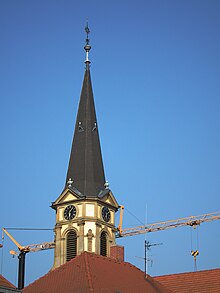Evangelical Church (Nussloch)
The Evangelical Church in Nußloch in the Rhein-Neckar district in northwest Baden-Württemberg was built in 1812.
history
After Elector Ottheinrich introduced the Reformation in the Palatinate in 1556 , Nussloch also had to follow the multiple changes of denomination over the years. For Reformed parish belonged Maisbach and after the Thirty Years' War and Walldorf . When the Palatinate church was divided, however , the Nussloch Church was awarded to the Catholics in 1707.
The Reformed community built a small emergency church, but there was no longer a parish. From 1715 the pastor in Walldorf was responsible. The church had to be closed in 1810 due to dilapidation. In 1812 the new church, which had a roof turret, was built. The inauguration was on January 10, 1813.
In addition to the Reformed, there was also a Lutheran congregation in Nussloch . It was looked after by the pastor of Leimen and built a small branch church in 1783/84. The baroque hall building with a gable decorated with volutes adapted in plan to the location directly at a fork in the street. In the Grand Duchy of Baden , to which Nussloch now belonged, Reformed and Lutherans merged in 1821 to form the United Evangelical-Protestant Church of Baden . The Lutheran church building was profaned and sold. The proceeds were used to pay off debts for the larger Reformed Church built in 1812.
In 1847 an independent Protestant parish was set up in Nussloch. At the end of the 19th century the church had become too small for the increased population. That is why it was expanded in 1901, and the dilapidated roof turret was removed and replaced with a church tower. In 1930 the church was painted, in 1938 the exterior plaster was renewed. A major renovation began in 2004, including the church tower, foyer and extensions as well as the interior.
description
The Protestant church is in the center of Nussloch not far from the old Lutheran church, which is now used as a community library. The classicist hall closes with a round choir . The church tower, built in 1901, is to the right of the choir. There is an inscription plaque above the main portal:
A wooden gallery runs around the interior on three sides. The two windows in the choir depict Jesus' crucifixion and resurrection.
Bells
The old bells would have been too small for the new tower from 1901, so three new bells were cast. This ringing (d´-fis´-a´) was known in the whole area because of its excellent sound.
The bells were supposed to be melted down during the First World War. But the efforts to save this bell for the sake of its musical value were successful: Both the Protestant and the Catholic Church were allowed to keep their bells. In the Second World War, however, the bells were not spared. On April 9, 1942, the National Socialists took off the two larger bells and melted them down for war purposes.
After the war, the community signed a contract with the Hamm bell foundry in Frankenthal for a four-bell ring with the tones c sharp-e-f sharp-g sharp (filled in minor motif). They were cast in 1950.
| Bell jar | Nominal | Diameter (cm) | Weight (kg) | inscription | Surname | function |
| 1 | C sharp 1 | 150 | 1780 | Eph. 2.14 | peace | Death knell |
| 2 | E1 | 125 | 1020 | Mt. 6.10 | hope | |
| 3 | F sharp 1 | 111 | 730 | Mt. 26, 41 | Faith | Prayer bell |
| 4th | G sharp 1 | 100 | 520 | 1st Cor. 13.8 | love | Baptismal bell |
The smallest of the old bells, which had rung alone during the chaos of war, was made available to the municipality of Oberacker near Bruchsal by the Nussloch community .
organ
The organ of the Evangelical Church in Nussloch was built in 2013 by the organ builder Richard Rensch from Lauffen. The instrument has 26 registers , 2 manuals and a pedal . It owns 1524 sounding pipes. The organ was built in Romantic style dispositioniert . It replaces the old Mann organ from 1963. It had 21 stops, 2 manuals, a pedal and was sold to a Polish community near Krakow.
|
|
|
|||||||||||||||||||||||||||||||||||||||||||||||||||||||||||||||||||||||||||||||||||||||||
-
Pairing :
- Normal coupling: II / I, I / P, II / P
- Sub-octave coupling: II / II (through coupling)
- Playing aids: Swell step for 2nd manual, crescendo roller, setting system with 30000 storage options, USB connection, MIDI
literature
- Rainer Laun: Rhein-Neckar-Kreis , in: Dagmar Zimdars u. a. (Ed.), Georg Dehio (Gre.): Handbook of German Art Monuments : Baden-Württemberg I. The administrative districts of Stuttgart and Karlsruhe . Munich 1993, ISBN 3-422-03024-7 .
- State Archive administration Baden-Württemberg in connection with d. Cities and districts Heidelberg u. Mannheim (Hrsg.): The city and the districts of Heidelberg and Mannheim: Official district description , Bd. 2: The city of Heidelberg and the communities of the district of Heidelberg . Karlsruhe 1968.
- Martin Kares, Michael Kaufmann, Godehard Weithoff: Organ guide Rhein-Neckar-Kreis . Heidelberg 2001, ISBN 3-932102-07-X .
Web links
Coordinates: 49 ° 19 '22.1 " N , 8 ° 41' 48.8" E


